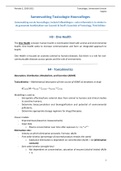Periode 3, 2020-2021 Toxicologie, Universiteit Utrecht
Cappie
Samenvatting Toxicologie Hoorcolleges
Samenvatting van de hoorcolleges, inclusief afbeeldingen – extra informatie is te vinden in
de genoemde hoofdstukken van Casarett & Doull’s Essentials of Toxicology, Third Edition
H3 - One Health
The One Health concept: human health is inextricably linked with animal and environmental
health. One health seeks to increase communication and form an integrated approach to
health.
One Health is focused on zoonotic (animal to human) diseases. But there is a role for non-
communicable diseases across species and the role of environment.
H4 - Toxicokinetics
Absorption, Distribution, Metabolism, and Excretion (ADME)
Toxicokinetics – Mathematical description of time course of ADME of xenobiotic in body
dCinside/dt = kinside * Coutside – koutside * Cinside
Modelling is used to:
- Extrapolate effective/toxic external dose from animal to humans and clinical studies
to sensitive humans;
- Determine bioaccumulation and biomagnification and potential of environmental
pollutants;
- Determine appropriate dosage regimens for drugs/therapies.
Classic models:
- Empirical basis (based on measurements)
- Input data
o Plasma concentration over time after exposure Ct = C0 * e-k*t
Elimination rate:
- Velocity at which elimination proceeds. Formula: dA/dt.
- First-order kinetics (percentage of excreted product remains the same)
o Substance elimination is dependent on concentration dA/dt = -kA (elimination
constant)
- Zero-order kinetics (straight line)
o Not dependent on concentration, saturation of enzyme (alcohol intake) dA/dt
= -k
1
,Periode 3, 2020-2021 Toxicologie, Universiteit Utrecht
Cappie
One-compartment model:
o Body as kinetically homogenous compartment – concentration in central
compartment (e.g., organism, plasma).
Slope of (ln)model of one-compartment is –kel
Two-compartment model:
o Body is a central compartment (e.g., plasma, highly perfused tissue) to a
peripheral compartment (e.g., slowly perfused tissue).
Characterised by fast and slow elimination. First is the distribution phase, where the molecules
move to the peripheral organs. Second is the elimination phase. Always look at one of the two
phases when calculating the slope.
Parameters
Volume of Distribution (Vd)
At = Vd * Ct
- Measure of distribution between blood, interstitial fluid, tissues etc.
- Proportionality constant, relating total amount of chemical to concentration in plasma,
Vd
2
,Periode 3, 2020-2021 Toxicologie, Universiteit Utrecht
Cappie
- Apparent volume of space into which toxicant in which toxicant would need to be
dissolved to have the same concentration as measure in plasma (e.g., L or L/kg body
weight)
High Vd is related to lipophilic distribution. = there is less available in the plasma.
Elimination half-life (T0.5)
- Time required to reduce the plasma concentration of a toxicant during the elimination
phase by 50%, T0.5
- Calculate treatment time necessary for toxicant concentration to reach safe level
- Elimination phase in two-compartment model.
Clearance (Cl)
- Volume of plasma cleared of xenobiotic per unit of time by whole body metabolism
and excretion, Cl
- Relates elimination rate from whole body to plasma concentration
- Fractional rate of elimination from Vd
Bioavailability (F)
- Fraction of dose administered orally or by inhalation that reaches the systemic
circulation, F
- Measure of extent of absorption of toxicant into body (as opposed to rate of
absorption)
- Between 0(%) to 1(00%)
3
, Periode 3, 2020-2021 Toxicologie, Universiteit Utrecht
Cappie
Other models/doses:
Using Multiple Doses
- If exposed continuously or intermittently, the xenobiotic accumulates until steady
state plasma concentration is reached.
- 2x dose -> 2x Css
- 2x T0.5 -> 2x Css
- +/- 5 T0.5 to reach a Steady State (ss)
Physiologically Based Models
- Referred to as physiologically based pharmacokinetic (PBPK), toxicokinetic (PBTK) and
biokinetic (PBBK) models.
- Process/mechanism based (not empirical).
- Series of mass balance differential equations simulating transport of chemicals
between organs:
o Used to simulate concentrations in a target organ
o Predict target dose and toxicity across species
o Simulate effects of changes in physiological conditions on target dose and
toxicity
These models use parameters such as:
- Anatomic (tissue volumes (V))
- Physiologic (tissue blood flow or respiration rate)
- Thermodynamic (partition coefficients, protein binding constants, tissue
clearance/elimination)
4





